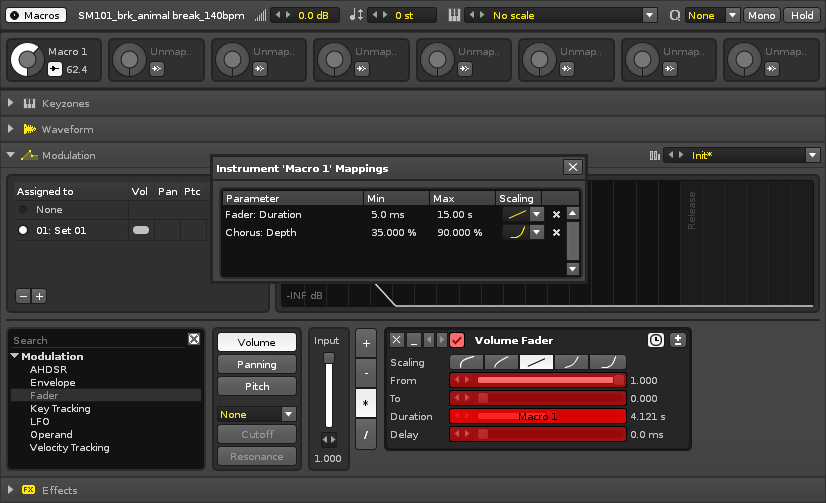Instruments
Instruments
To edit an instrument or create a new one, select an existing instrument or empty slot from the list in the Instrument Selector panel. An instrument in Renoise may be one or any combination of samples, plugins and MIDI, and each type can be edited by selecting the appropriate tab from the top left of the Renoise interface:
Instrument Properties
An instrument's properties affects the audio produced by all three sources. You will find these options at the top right of the instrument editor.
- Volume: The instrument's volume.
- Pitch: The instrument's pitch, in semi-tonal increments.
- Scale: Forces note playing and recording to conform to a chosen scale by making restricted notes (shown as green on the keyboard) play as desired notes. When a scale is selected, an additional option will appear to left of it for choosing the scale's key.
- Quantize: The time resolution of quantization. Choose from Line, Beat or Bar.
- Mono: When playing/recording notes, this restricts the instrument to using only a single note at once. Simultaneous notes in the Pattern Editor will still be played.
- Hold: When playing/recording notes, Note-Off (key release) messages are ignored and the instrument continues playing until the note is pressed a second time. Note-Offs in the Pattern Editor will behave as normal.
You can also access these options in the Instrument Properties section under the Instrument Selector.
Detaching The Editor
Just above the instrument properties and to the left of the Scopes options is the ![]() Detach button. It opens the instrument editor in a completely separate window, which can be moved around and resized. There are also additional buttons at the window's top right corner for minimizing, maximizing and closing. Clicking
Detach button. It opens the instrument editor in a completely separate window, which can be moved around and resized. There are also additional buttons at the window's top right corner for minimizing, maximizing and closing. Clicking ![]() Attach will reattach the window to the main interface.
Attach will reattach the window to the main interface.
Macros
Macros allow the automation of a sample-based instrument's modulation and fx parameters via the *Instr. Macros track effect. Only available in the Sampler tab, the ![]() button is located at the top left corner of the instrument editor. Pressing this will open a panel with eight macros, each of which can be assigned to any number of parameters. Automating a macro will then alter the values of all assigned parameters.
button is located at the top left corner of the instrument editor. Pressing this will open a panel with eight macros, each of which can be assigned to any number of parameters. Automating a macro will then alter the values of all assigned parameters.
To rename a macro, just click on its name. To map a macro, press the ![]() button to open the mappings list and reveal any mappable parameters (by default, highlighted in red). Clicking on a parameter will add it to the list and allow you to specify its Min/Max values and Scaling. Pressing the X at the right will delete the mapping.
button to open the mappings list and reveal any mappable parameters (by default, highlighted in red). Clicking on a parameter will add it to the list and allow you to specify its Min/Max values and Scaling. Pressing the X at the right will delete the mapping.
You can also access the macros in the Instrument Properties section under the Instrument Selector.
Scopes
The Scopes provide a visual representation of your song, allowing you to examine the frequency and amplitude of the final audio signal or see what's currently happening in each individual track. The icons for toggling the Scopes can be found near the top right of the interface:
 - Shows the Track Scopes.
- Shows the Track Scopes. - Shows the Master Spectrum.
- Shows the Master Spectrum. - Opens or closes the Scopes/Spectrum panel. Note you can have them independently open or closed for the main interface and the Instrument Editor.
- Opens or closes the Scopes/Spectrum panel. Note you can have them independently open or closed for the main interface and the Instrument Editor. - When the main interface's right panel containing the Disk Browser and Instrument Selector is closed, this icon will appear, allowing you to still view the Instrument Selector.
- When the main interface's right panel containing the Disk Browser and Instrument Selector is closed, this icon will appear, allowing you to still view the Instrument Selector.
Keyboard
The keyboard will display any keys pressed on the computer keyboard or played by a MIDI device. You can also use the mouse to click on the keys to play them. If not all keys are visible, the arrow buttons at the left and right sides will move the keyboard an octave in that direction. You can open the Phrase Editor by pressing the button next to the keyboard.
Track Selector
Unless the Instrument Editor has been detached, this option will be present at the bottom left of the interface and allows you to select a track to play sounds on without having to move back to the Pattern Editor.

